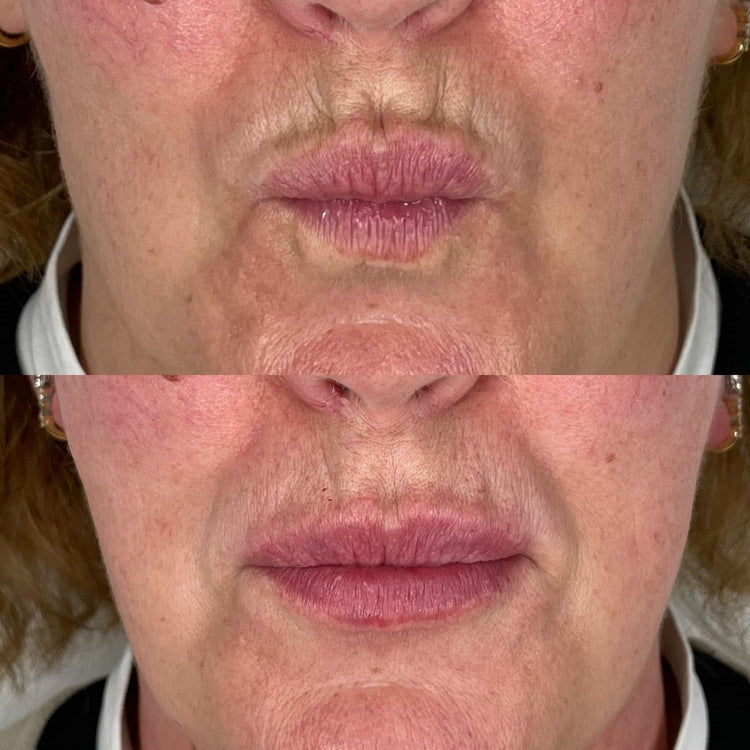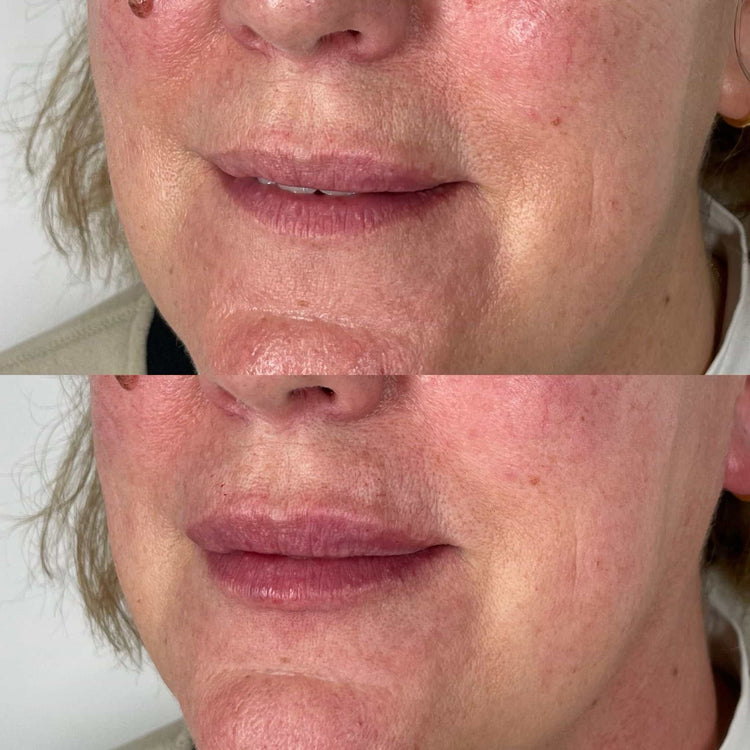What Are Dermal Fillers?
Dermal fillers are injectable substances used to add volume and fullness to various areas of the face. They are made from different materials, such as hyaluronic acid, which naturally occurs in the body, or synthetic polymers. Fillers can smooth wrinkles, plump lips, define cheekbones, and enhance facial contours.
How They Work
Dermal fillers are injectable substances used to add volume and fullness to various areas of the face. They are made from different materials, such as hyaluronic acid, which naturally occurs in the body, or synthetic polymers. Fillers can smooth wrinkles, plump lips, define cheekbones, and enhance facial contours.
Smile lines, also known as nasolabial folds, are creases that run from the sides of the nose to the corners of the mouth. They are a common sign of aging and can make the face appear tired or sad. Dermal fillers can effectively treat smile lines by restoring volume to the area.
- Hyaluronic acid fillers attract water molecules, plumping up the skin and smoothing out wrinkles.
- The results of dermal filler injections for smile lines are typically long-lasting, lasting anywhere from six months to two years depending on the type of filler used.
- The procedure is relatively quick and simple, usually taking just 15-30 minutes.
Types of Fillers Used for Smile Lines
Smile lines, also known as nasolabial folds, are creases that run from the sides of the nose to the corners of the mouth. They are a common sign of aging and can make the face appear tired or sad. Dermal fillers can effectively treat smile lines by restoring volume to the area.
There are different types of dermal fillers used for treating smile lines. Hyaluronic acid fillers, which are made from a substance naturally found in the body, are very popular.
Hyaluronic acid fillers attract water molecules, plumping up the skin and smoothing out wrinkles. Other types of fillers may be used depending on individual needs.
Benefits of Using Dermal Fillers for Smile Lines
Smile lines, those creases that run from the nose to the corners of the mouth, are a natural part of aging. While they can add character, they often make the face appear tired or aged. Luckily, dermal fillers offer a quick and effective solution for restoring volume and smoothing these lines, leading to a more refreshed and youthful appearance.
Minimizing the Appearance of Wrinkles
Dermal fillers provide several benefits for minimizing the appearance of smile lines. By adding volume to the area around the nose and mouth, they effectively smooth out the creases, reducing their visibility.
Hyaluronic acid, a common ingredient in dermal fillers, attracts water molecules, plumping up the skin and enhancing its elasticity. This helps to fill in the depressions caused by smile lines, making them appear less pronounced.
The results of dermal filler injections are generally long-lasting, with effects typically lasting anywhere from six months to two years. This allows individuals to enjoy a refreshed appearance for an extended period.
Restoring Facial Volume

Dermal fillers can be a great way to address smile lines, also known as nasolabial folds. These creases that run from the sides of the nose to the corners of the mouth are a common sign of aging.
- Hyaluronic acid fillers attract water molecules, plumping up the skin and smoothing out wrinkles.
- The results of dermal filler injections for smile lines are typically long-lasting, lasting anywhere from six months to two years depending on the type of filler used.
- Dermal fillers can provide a quick and effective way to restore volume and smooth these lines, leading to a more refreshed and youthful appearance.
Enhancing Cheekbones and Jawline Definition (Optional)

Smile lines, also known as nasolabial folds, are creases that run from the sides of the nose to the corners of the mouth. They are a common sign of aging and can make the face appear tired or sad. Dermal fillers can effectively treat smile lines by restoring volume to the area.
- Hyaluronic acid fillers, which are made from a substance naturally found in the body, are very popular.
- Hyaluronic acid fillers attract water molecules, plumping up the skin and smoothing out wrinkles.
- Dermal fillers can be a great way to address smile lines, also known as nasolabial folds.
Procedure Overview
This overview will detail the procedure of using dermal fillers to minimize the appearance of smile lines. Smile lines are creases that run from the sides of the nose to the corners of the mouth and are a common sign of aging. Dermal fillers offer a quick and effective solution for smoothing these lines, leading to a more refreshed and youthful look.
Consultation and Assessment
Before undergoing any dermal filler procedure, it’s essential to have a consultation with a qualified healthcare professional, such as a dermatologist or plastic surgeon. During this consultation, the practitioner will assess your individual needs, medical history, and desired outcome. They will also discuss the different types of fillers available and explain the procedure in detail.
The assessment involves examining the smile lines and determining the appropriate amount of filler needed. The practitioner may take photographs to document your current appearance and track any changes after treatment. They will also address any concerns or questions you may have about the procedure, potential risks, and expected results.
Injection Technique
The injection technique for dermal fillers used in treating smile lines involves precise placement of the filler material beneath the skin. The practitioner uses a fine needle to inject the filler along the nasolabial fold, strategically targeting areas that require volume restoration.
The amount of filler injected is determined by individual needs and desired results. Multiple injection sites may be used to ensure even distribution and optimal smoothing of the smile lines.
After each injection, the practitioner may gently massage the area to distribute the filler evenly and minimize any visible lumps or bumps.
Expected Downtime and Recovery
The procedure for dermal filler injections is relatively quick and straightforward. It typically takes about 15-30 minutes to complete.
Minimal downtime is expected following treatment. You may experience some mild redness, swelling, or bruising at the injection sites, which usually subside within a few days.
Most people can resume their normal activities immediately after the procedure. It’s advisable to avoid strenuous activity and direct sunlight for a few days following treatment.
Risks and Side Effects
While dermal fillers offer a promising solution for minimizing the appearance of smile lines, it’s crucial to be aware of potential risks and side effects. Like any medical procedure, there are some possible complications associated with filler injections. These can include temporary swelling, redness, bruising, or tenderness at the injection sites. In rare cases, more serious complications such as infection, allergic reactions, or vascular occlusion (blockage of blood vessels) may occur.
Common Reactions
It’s essential to have realistic expectations and understand that dermal fillers are not a permanent solution. Results typically last from six months to two years, after which touch-up injections may be necessary to maintain the desired appearance.
As with any medical procedure, there is a possibility of experiencing side effects. Common reactions include temporary redness, swelling, bruising, and tenderness at the injection sites. These usually subside within a few days.
It’s important to discuss your medical history, medications, and any allergies with your healthcare provider before undergoing dermal filler treatment. This will help them determine the safest and most effective course of treatment for you.
Rare but serious side effects can include infection, allergic reactions, or vascular occlusion. Seek immediate medical attention if you experience any unusual or concerning symptoms after treatment.
Allergic Reactions
While dermal fillers offer a promising solution for minimizing the appearance of smile lines, it’s crucial to be aware of potential risks and side effects. Like any medical procedure, there are some possible complications associated with filler injections. These can include temporary swelling, redness, bruising, or tenderness at the injection sites. In rare cases, more serious complications such as infection, allergic reactions, or vascular occlusion (blockage of blood vessels) may occur.
It’s essential to have realistic expectations and understand that dermal fillers are not a permanent solution. Results typically last from six months to two years, after which touch-up injections may be necessary to maintain the desired appearance.
As with any medical procedure, there is a possibility of experiencing side effects. Common reactions include temporary redness, swelling, bruising, and tenderness at the injection sites. These usually subside within a few days.
It’s important to discuss your medical history, medications, and any allergies with your healthcare provider before undergoing dermal filler treatment. This will help them determine the safest and most effective course of treatment for you.
Rare but serious side effects can include infection, allergic reactions, or vascular occlusion. Seek immediate medical attention if you experience any unusual or concerning symptoms after treatment.
Longevity of Results
Dermal fillers offer a relatively safe and effective way to minimize the appearance of smile lines. However, it’s essential to be aware of potential risks and side effects.
Common side effects are typically mild and temporary, such as redness, swelling, bruising, or tenderness at the injection sites. These usually subside within a few days.
More serious side effects are rare but can occur. These include infection, allergic reactions, or vascular occlusion (blockage of blood vessels). If you experience any unusual or concerning symptoms after treatment, seek immediate medical attention.
The longevity of results from dermal filler injections for smile lines varies depending on the type of filler used and individual factors.
Generally, results last anywhere from six months to two years. As the body gradually breaks down the filler material over time, touch-up injections may be needed to maintain the desired appearance.
Choosing a Qualified Provider
When considering dermal fillers for smile lines, choosing a qualified provider is crucial for ensuring safe and effective results. Look for a healthcare professional with experience and expertise in administering dermal fillers, such as a board-certified dermatologist or plastic surgeon.
Importance of Experience and Credentials
Choosing a qualified provider is essential when considering dermal fillers for smile lines.
- Experience: Opt for a practitioner with extensive experience in administering dermal fillers specifically for treating smile lines.
- Credentials: Verify that the healthcare professional holds appropriate medical licenses and certifications, such as board certification by a recognized medical board.
Asking the Right Questions
Choosing a qualified provider is essential when considering dermal fillers for smile lines.
Here’s what to look for:
* **Experience:** Opt for a practitioner with extensive experience in administering dermal fillers specifically for treating smile lines.
* **Credentials:** Verify that the healthcare professional holds appropriate medical licenses and certifications, such as board certification by a recognized medical board.
* **Consultation:** Schedule a consultation to discuss your goals, concerns, and medical history. A good provider will thoroughly explain the procedure, risks, and expected results. Ask about their approach to treating smile lines and their experience with different types of dermal fillers.
Don’t hesitate to ask questions and seek a second opinion if needed. Your comfort and safety should be paramount when making this decision.
Alternatives to Dermal Fillers
While dermal fillers offer a popular solution for addressing smile lines, exploring alternative options might be beneficial for some individuals. These alternatives can range from non-invasive treatments to lifestyle changes that promote skin health.
Botox for Smile Lines
Besides dermal fillers, several alternatives exist for minimizing the appearance of smile lines.
- Topical Treatments: Retinoids, vitamin C serums, and hyaluronic acid moisturizers can improve collagen production and skin elasticity, helping to reduce the depth of smile lines over time.
- Chemical Peels: Chemical peels remove the outer layer of skin, revealing smoother, younger-looking skin beneath. They can be effective in reducing the appearance of fine lines and wrinkles, including smile lines.
- Microneedling: This procedure involves creating tiny punctures in the skin using fine needles, stimulating collagen production and improving skin texture.
- Laser Treatments: Certain laser therapies can target and reduce wrinkles by stimulating collagen growth or resurfacing the skin.
- Facial Exercises: Strengthening facial muscles through targeted exercises may help improve skin tone and minimize the appearance of smile lines.
- Lifestyle Changes:** Protecting your skin from sun damage with sunscreen, maintaining a healthy diet rich in antioxidants, and staying hydrated can all contribute to healthier skin and reduce the appearance of wrinkles.
Other Facial Rejuvenation Options
Alternatives to dermal fillers for treating smile lines include topical treatments, chemical peels, microneedling, laser therapy, facial exercises, and lifestyle changes.
Topical treatments like retinoids, vitamin C serums, and hyaluronic acid moisturizers can improve skin elasticity and reduce the appearance of wrinkles over time. Chemical peels remove the top layer of skin, revealing smoother skin underneath and diminishing fine lines.
Microneedling involves creating tiny punctures in the skin to stimulate collagen production, improving skin texture and reducing wrinkle depth. Laser treatments target wrinkles by stimulating collagen growth or resurfacing the skin. Facial exercises can strengthen facial muscles, potentially minimizing smile lines.
Finally, protecting your skin from sun damage, eating a healthy diet, and staying hydrated all contribute to overall skin health and can help reduce the appearance of wrinkles.
Book your wrinkle-smoothing treatment with Dr. Laura Geige at It’s Me & You Clinic
- Why Does Lip Filler Swell In The Morning - November 7, 2025
- What Is The Best Treatment For A Sagging Neck? - November 6, 2025
- What Are The Best CBD Gummies For Sleep And Restful Nights? - November 5, 2025
